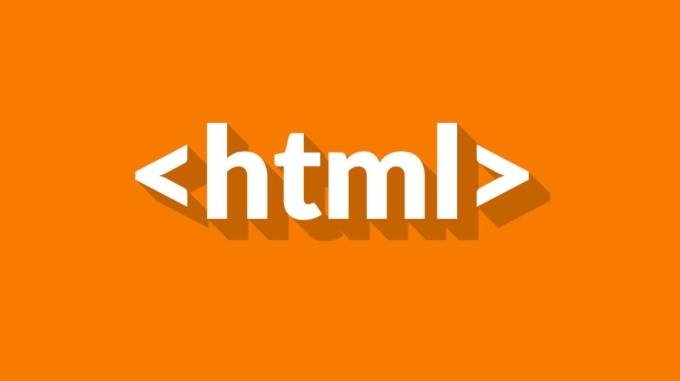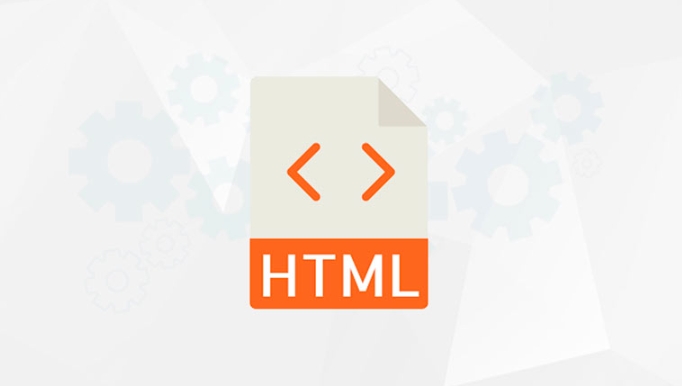Using native <button> elements is usually better than role="button" because the former comes with interactive features and barrier-free support. 1. <button> can focus and respond to Enter and Space keys by default; 2. Automatically submit forms and follow browser accessibility standards; 3. role="button" requires manual keyboard interaction, focus style and ARIA attributes; 4. role="button" should be used only in specific scenarios such as SVG or in restricted systems; 5. Use native buttons to save time and improve accessibility experience.
 element?">
element?">
If you're trying to make something clickable on a webpage—like a <div> or a <code><span></span> —you might come across role="button" and wonder how it's different from just using a real <button></button> element. The short answer is: they're not the same, and in most cases, using a native <button></button> is better unless you have a specific reason not to.  element?" /> element?" />
element?" /> element?" />
Here's what you need to know about the difference between role="button" and the actual <button></button> element.
Accessibility Basics: What Screen Readers See
When you use a regular <button></button> , screen readers automatically recognize it as an interactive element. They announce it properly, like “button” or “clickable,” and users know they can interact with it.
 element?" /> element?" />
element?" /> element?" /> If you slap role="button" onto a <div> or <code><span></span> , it does tell assistive tech that this thing is supposed to act like a button—but that's all it does. You still have to manually handle keyboard interactions (like Enter key presses), focus styles, and ARIA attributes. So while screen readers may say "button," it won't behave like one without extra code.
Native Button Handles Interaction Automatically
A real <button></button> comes with built-in functionality:
 element?" /> element?" />
element?" /> element?" />- It's focused by default
- It responds to Enter and Space key presses
- It submits forms if type is
submit - It follows browser accessibility standards out of the box
With role="button" , none of that works unless you add event listeners for keydown , focus , click , etc., yourself. For example, you'd need to do something like this:
element.addEventListener('keydown', function(e) {
if (e.key === 'Enter' || e.key === ' ') {
e.preventDefault();
// Trigger your action here
}
});And don't forget to manage focus and visual indicators so keyboard users know where they are.
Styling and Use Cases: When to Choose One Over the Other
Sometimes people avoid <button> because it has default styling that's hard to reset across browsers. But that's not a good reason to switch to role="button" . Instead, just reset the button styles:
button {
background: none;
border: none;
padding: 0;
font: inherit;
cursor: pointer;
} Use role="button" only when:
- You're working with elements that can't be buttons semantically (like inside SVGs)
- You're enhancing a non-form control that needs to look and act like a button but isn't one structurally
- Legacy systems or frameworks restrict using
<button></button>
But even then, always test for keyboard navigation and screen reader support.
Final Thoughts
So yes, role="button" makes an element announcement like a button, but it doesn't make it behave like one. If you go that route, you'll have to wire up all the expected behavior manually.
The <button></button> element, on the other hand, gets you 90% of the way there right out of the gate. Unless you have a strong reason otherwise, stick with native controls—they save time and improve accessibility by default.
Basically that's it.
The above is the detailed content of What is the difference between role='button' and the element?. For more information, please follow other related articles on the PHP Chinese website!

Hot AI Tools

Undress AI Tool
Undress images for free

Undresser.AI Undress
AI-powered app for creating realistic nude photos

AI Clothes Remover
Online AI tool for removing clothes from photos.

Clothoff.io
AI clothes remover

Video Face Swap
Swap faces in any video effortlessly with our completely free AI face swap tool!

Hot Article

Hot Tools

Notepad++7.3.1
Easy-to-use and free code editor

SublimeText3 Chinese version
Chinese version, very easy to use

Zend Studio 13.0.1
Powerful PHP integrated development environment

Dreamweaver CS6
Visual web development tools

SublimeText3 Mac version
God-level code editing software (SublimeText3)

Hot Topics
 Explain the purpose of the role attribute in ARIA.
Jun 14, 2025 am 12:35 AM
Explain the purpose of the role attribute in ARIA.
Jun 14, 2025 am 12:35 AM
ARIA's role attribute is used to define the role of web elements and improve accessibility. 1. Role attribute helps assistive technology to understand the functions of elements, such as buttons, navigation, etc. 2. Use role attributes to assign specific roles to non-semantic HTML elements. 3. The role attribute should be consistent with the element behavior and be verified by the accessibility tool test.
 HTML and Design: Creating the Visual Layout of Websites
Jun 14, 2025 am 12:39 AM
HTML and Design: Creating the Visual Layout of Websites
Jun 14, 2025 am 12:39 AM
How to create a website layout? 1. Use HTML tags to define the content structure, such as, ,. 2. Control styles and positions through CSS, using box model, float or Flexbox layout. 3. Optimize performance, reduce HTTP requests, use cache and optimize images, and ensure responsive design.
 How do I stay up-to-date with the latest HTML standards and best practices?
Jun 20, 2025 am 08:33 AM
How do I stay up-to-date with the latest HTML standards and best practices?
Jun 20, 2025 am 08:33 AM
The key to keep up with HTML standards and best practices is to do it intentionally rather than follow it blindly. First, follow the summary or update logs of official sources such as WHATWG and W3C, understand new tags (such as) and attributes, and use them as references to solve difficult problems; second, subscribe to trusted web development newsletters and blogs, spend 10-15 minutes a week to browse updates, focus on actual use cases rather than just collecting articles; second, use developer tools and linters such as HTMLHint to optimize the code structure through instant feedback; finally, interact with the developer community, share experiences and learn other people's practical skills, so as to continuously improve HTML skills.
 How do I use the element to represent the main content of a document?
Jun 19, 2025 pm 11:09 PM
How do I use the element to represent the main content of a document?
Jun 19, 2025 pm 11:09 PM
The reason for using tags is to improve the semantic structure and accessibility of web pages, make it easier for screen readers and search engines to understand page content, and allow users to quickly jump to core content. Here are the key points: 1. Each page should contain only one element; 2. It should not include content that is repeated across pages (such as sidebars or footers); 3. It can be used in conjunction with ARIA properties to enhance accessibility. Usually located after and before, it is used to wrap unique page content, such as articles, forms or product details, and should be avoided in, or in; to improve accessibility, aria-labeledby or aria-label can be used to clearly identify parts.
 How do I create a basic HTML document?
Jun 19, 2025 pm 11:01 PM
How do I create a basic HTML document?
Jun 19, 2025 pm 11:01 PM
To create a basic HTML document, you first need to understand its basic structure and write code in a standard format. 1. Use the declaration document type at the beginning; 2. Use the tag to wrap the entire content; 3. Include and two main parts in it, which are used to store metadata such as titles, style sheet links, etc., and include user-visible content such as titles, paragraphs, pictures and links; 4. Save the file in .html format and open the viewing effect in the browser; 5. Then you can gradually add more elements to enrich the page content. Follow these steps to quickly build a basic web page.
 What is an HTML tag?
Jun 13, 2025 am 12:36 AM
What is an HTML tag?
Jun 13, 2025 am 12:36 AM
HTMLtagsareessentialforstructuringwebpages.Theydefinecontentandlayoutusinganglebrackets,ofteninpairslikeand,withsomebeingself-closinglike.HTMLtagsarecrucialforcreatingstructured,accessible,andSEO-friendlywebpages.
 How do I create checkboxes in HTML using the element?
Jun 19, 2025 pm 11:41 PM
How do I create checkboxes in HTML using the element?
Jun 19, 2025 pm 11:41 PM
To create an HTML checkbox, use the type attribute to set the element of the checkbox. 1. The basic structure includes id, name and label tags to ensure that clicking text can switch options; 2. Multiple related check boxes should use the same name but different values, and wrap them with fieldset to improve accessibility; 3. Hide native controls when customizing styles and use CSS to design alternative elements while maintaining the complete functions; 4. Ensure availability, pair labels, support keyboard navigation, and avoid relying on only visual prompts. The above steps can help developers correctly implement checkbox components that have both functional and aesthetics.
 How do I minimize the size of HTML files?
Jun 24, 2025 am 12:53 AM
How do I minimize the size of HTML files?
Jun 24, 2025 am 12:53 AM
To reduce the size of HTML files, you need to clean up redundant code, compress content, and optimize structure. 1. Delete unused tags, comments and extra blanks to reduce volume; 2. Move inline CSS and JavaScript to external files and merge multiple scripts or style blocks; 3. Simplify label syntax without affecting parsing, such as omitting optional closed tags or using short attributes; 4. After cleaning, enable server-side compression technologies such as Gzip or Brotli to further reduce the transmission volume. These steps can significantly improve page loading performance without sacrificing functionality.






